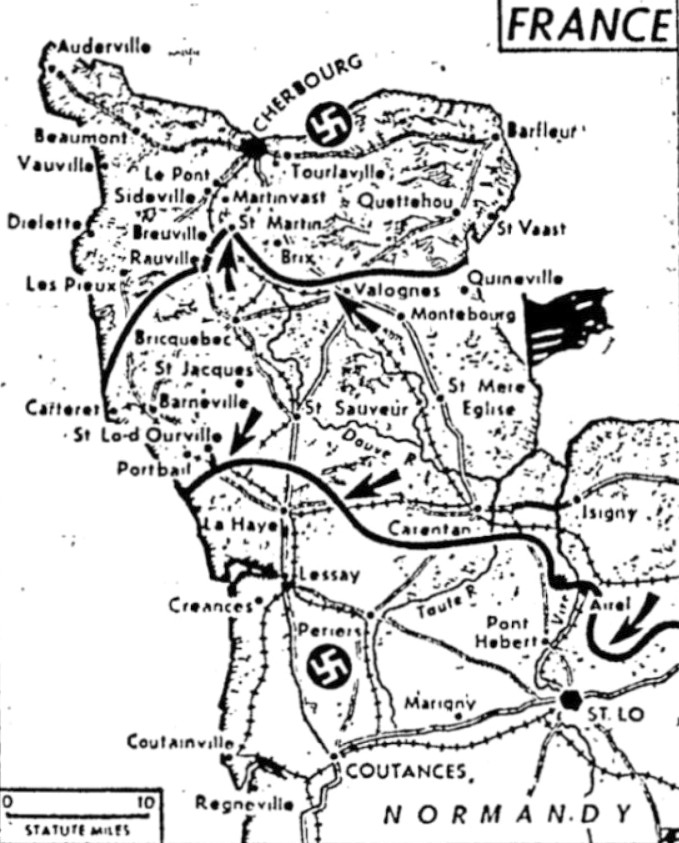The Free Lance-Star (June 21, 1944)
U.S. AND JAP FLEETS LOCKED IN BATTLE
Full-scale naval engagement believed in progress off Philippine Islands
U.S. commanders eager to bring enemy to action
USPACFLT HQ, Pearl Harbor, Hawaii (AP) –
Giant battle fleets of the United States and Japan faced each other today in the 1,500 miles between the Philippines and Marianas amid indications that preliminary blows may have already opened a history-shaking naval engagement.
“Possibly the entire Japanese fleet” has entered the area, Adm. Chester W. Nimitz disclosed. It was the first report on the whereabouts of the long-sought Navy of Nippon since its crushing defeat at Midway in June 1942.
Eager and ready for battle is the Fifth Fleet with “enough muscle… to take care of everything” in the words of the confident Commander-in-Chief of the Pacific Fleet.
A Japanese naval spokesman was quoted in a Berlin broadcast today as saying Nippon’s air and naval forces “have successfully engaged an American fleet,” but Tokyo radio, in another broadcast to the homeland, quoted an Imperial Headquarters communiqué as acknowledging “we have suffered considerable losses of ships and planes.”
Hard land battle
On the embattled Saipan, in the Marianas 1,500 miles southeast of Tokyo, the going is still tough. The Yanks called on planes, artillery and guns of warships to help crack bitter resistance of an estimated 20,000 Japanese, a Nimitz communiqué last night reported.
The communiqué said:
Our troops now hold the entire southern portion of the island from the southern outskirts of Garapan [principal city of 10,000 six miles up the southwest shore] across to the center of the western shore of Magicienne Bay [three and a half miles up the island’s southeast side].
To the south of Saipan, enemy airfield on Tinian were shelled by warships and bombed by planes. Saipan was invaded June 14.
What may prove to have been the first preliminary blow of a showdown naval fight was struck Sunday from enemy aircraft carriers. Their planes, flying from the direction of the Philippines by way of Guam and Rota in the Marianas, paid a frightful cost of 300 aircraft in trying unsuccessfully to sunk U.S. carriers and battleships of the invasion fleet. Last night, Nimitz told a press conference that not one combat ship was sunk.
Then the admiral issued an electrifying hint that the enemy blow was paid back with success Monday. He said cryptically it was possible that damage was inflicted on elements of the enemy fleet that day.
Has abundant power
Nimitz assured a press conference the Fifth Fleet packs sufficient “power to be favorable to us in a decisive engagement,” even if it is massed more than 1,000 miles beyond the U.S. advance naval base in the Marshalls and 3,800 miles from Pearl Harbor.
He said:
We hope the Jap fleet will stay in that [Philippines] area. As long as they stay, we have a chance to get at them.
Ready to figure in a decisive naval engagement is an “unsinkable carrier,” the 3,600-foot Aslito Airdrome captured by Marines and soldiers.
Also ready to send land-based bombers into action is the air arm of Gen. Douglas MacArthur. His planes are poised within bombing range of the Philippines and adjacent ocean area at captured Mokmer Airfield on Biak in the Schouten Islands off North Dutch New Guinea. Today, he announced the capture of two more airfields on Biak.
600 planes destroyed
The destruction of the enemy’s 300 carrier planes, extremely costly because of the long training required for carrier pilots, raised to nearly 600 the total Japanese air losses in the Marianas since the U.S. carrier task force moved against that segment of Nippon’s inner defense perimeter.
Nimitz said:
If we lost 600 naval planes in two or three days, we’d be very unhappy, even with our plane production.
Nimitz emphasized that he had expected Japan’s violent reaction at Saipan because it is in the last island defense line before China and the Philippines.
The 72-square-mile island was invaded “on the assumption the Japanese would bring out everything they possible could.”
He expressed conviction Japan no longer possesses the naval strength to use the Marianas for an offensive, but “the Japs need to hold them to keep us from penetrating west of their island defense line.”
“And north, too,” interposed RAdm. C. H. McMorris, chief of staff, with an eye on the Japanese homeland.
Nimitz said the Aslito Airdrome will promote “control of the air in the immediate Marianas area.” But, considering all the angles, he noted the Japanese hold the advantage of land-based air reconnaissance west of the Marianas and that the first concern of the U.S. Fleet must be to safeguard the Saipan invaders. Even so, he was supremely confident.
He said:
I can’t control Japanese fleet movements. If I did, there definitely would be a naval engagement.

